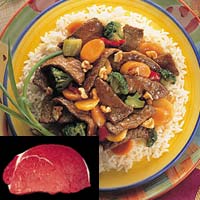Gluten Free
What does following a gluten-free diet mean? That you're embarking on an easy diet with a wide range of health-promoting effects. Instead of dwelling on what you’re giving up, consider that you’re going to enjoy a whole new world of delicious food options to meet your special dietary needs. You’ll be eating seasonally, choosing more fresh fruits and vegetables, focusing on meats, seafood, poultry, legumes, lentils, corn, and rice, and discovering fascinating ancient grains such as quinoa, amaranth, and millet. You’ll be able to eat potatoes, eggs, most cheeses, even chocolate (!)—and enjoy them without guilt because you’ll be taking good care of your body. In fact, you’ll probably end up eating—and feeling—better than ever!
Visit this page for more information about living Gluten Free
---
We carry a large variety of gluten free items, the brands listed below represent just some of the offerings we carry















More Diets
Beef Stir-Fry

Preparation, Uses, & Tips
Since cut-up beef is particularly vulnerable to bacteria, it should always be cooked to an internal temperature of 160°F (70°C).
To create stir-fry pieces yourself, cut beef in thin slices against the grain. Thin slicing is easier if you first put the meat in the freezer for ten minutes so it is partly solidified. For the stir-fry process, heat a small amount of oil in a wok or skillet over medium or medium-high heat and cook the meat in batches, stirring and tossing until the beef is no longer pink.
Stew
There are two methods for making stew. Brown stew calls for meat pieces that are first browned in oil. In “white stew” or blanquette, the pieces are cooked in liquid without the initial browning. Browning the meat caramelizes its outside surfaces, and is thought to give the stew a richer taste.
To brown-stew, heat a heavy skillet over medium to medium-high heat and add oil. Working in batches, brown all sides of pre-cut beef cubes. Add cooking liquid and seasonings and simmer until beef is fork-tender, 1 to 2 hours. To white-stew, simply skip the browning and cook the meat in liquid and seasonings until tender.
Kabobs
Cut beef into uniform cubes or strips. If using cuts from the round, marinate the cubes for several hours or overnight. Marinades are seasoned liquids containing tenderizing ingredients, either acidic foods such as lemon juice, wine, vinegar, and tomato juice, or natural tenderizers such as pineapple, papaya, or ginger. Place the kabob beef in an acid-resistant container and add marinade, about 1/4 to 1/2 cup (59.1–118.2ml) for each 1 to 2 pounds (0.45–0.90 kg) of meat. Turn to make sure marinade touches all the meat surfaces, cover, and marinate in the refrigerator for several hours or overnight. Marinades can be used in making sauce that will be broiled, but never consume marinades that have come in contact with raw meat unless they have been thoroughly cooked.
Grill
Thread kabob meat on skewers and place directly over the heat source. Grill 8 to 18 minutes, depending on the thickness of the meat.
Copyright © 2026 TraceGains, Inc. All rights reserved.
Learn more about TraceGains, the company.
The information presented in the Food Guide is for informational purposes only and was created by a team of US–registered dietitians and food experts. Consult your doctor, practitioner, and/or pharmacist for any health problem and before using any supplements, making dietary changes, or before making any changes in prescribed medications. Information expires December 2026.










